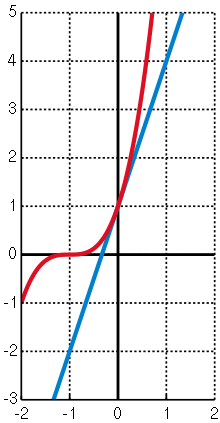Bernoulli's inequality

In real analysis, Bernoulli's inequality (named after Jacob Bernoulli) is an inequality that approximates exponentiations of 1 + x.
The inequality states that
for every integer r ≥ 0 and every real number x ≥ −1. If the exponent r is even, then the inequality is valid for all real numbers x. The strict version of the inequality reads
for every integer r ≥ 2 and every real number x ≥ −1 with x ≠ 0.
There is also a generalized version that says for every real number r ≥ 1 and real number x ≥ -1,
while for 0 ≤ r ≤ 1 and real number x ≥ -1,
Bernoulli's inequality is often used as the crucial step in the proof of other inequalities. It can itself be proved using mathematical induction, as shown below.
History
Jacob Bernoulli first published the inequality in his treatise “Positiones Arithmeticae de Seriebus Infinitis” (Basel, 1689), where he used the inequality often.[1]
According to Joseph E. Hofmann, Über die Exercitatio Geometrica des M. A. Ricci (1963), p. 177, the inequality is actually due to Sluse in his Mesolabum (1668 edition), Chapter IV "De maximis & minimis".[1]
Proof of the inequality
For r = 0,
is equivalent to 1 ≥ 1 which is true as required.
Now suppose the statement is true for r = k:
Then it follows that
By induction we conclude the statement is true for all r ≥ 0.
Generalization
The exponent r can be generalized to an arbitrary real number as follows: if x > −1, then
for r ≤ 0 or r ≥ 1, and
for 0 ≤ r ≤ 1.
This generalization can be proved by comparing derivatives. Again, the strict versions of these inequalities require x ≠ 0 and r ≠ 0, 1.
Related inequalities
The following inequality estimates the r-th power of 1 + x from the other side. For any real numbers x, r > 0, one has
where e = 2.718.... This may be proved using the inequality (1 + 1/k)k < e.
Alternative form
An alternative form of Bernoulli's inequality for and is:
This can be proved (for integer t) by using the formula for geometric series: (using y=1-x)
or equivalently
Proof using AM-GM
An elementary proof for can be given using Weighted AM-GM.
Let be two non-negative real constants. By Weighted AM-GM on with weights respectively, we get
Note that
and
so our inequality is equivalent to
After substituting (bearing in mind that this implies ) our inequality turns into
which is Bernoulli's inequality.
Notes
References
- Carothers, N.L. (2000). Real analysis. Cambridge: Cambridge University Press. p. 9. ISBN 978-0-521-49756-5.
- Bullen, P. S. (2003). Handbook of means and their inequalities. Dordercht [u.a.]: Kluwer Academic Publ. p. 4. ISBN 978-1-4020-1522-9.
- Zaidman, S. (1997). Advanced calculus : an introduction to mathematical analysis. River Edge, NJ: World Scientific. p. 32. ISBN 978-981-02-2704-3.
External links
- Bernoulli Inequality by Chris Boucher, Wolfram Demonstrations Project.
- Arthur Lohwater (1982). "Introduction to Inequalities". Online e-book in PDF format.
- Paper “Some Equivalent Forms of Bernoulli’s Inequality: A Survey“